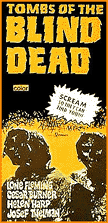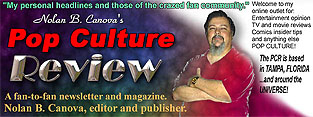Zombie films came of birth in 1968 with George A. Romero's "Night of the Living Dead". By the early 70s there were already numerous cash-ins but with these cash-ins also came true classics. And then at the end of the decade, the purveyor of the sub-genre, Romero, topped it all off with his sequel, "Dawn of the Dead".
 The decade started out good with two films that defined the European asthetic of a zombie film. The films in question are part of a series by Spanish director Amando De Ossario, "Tombs of the Blind Dead" and "Return of the Blind Dead". De Ossarios' zombies are former Knight Templars that were executed for Satan worship and murder. Their eyes were eaten out by vultures and their bodies left to rot in the sun. The Knights are now blind but can hear any movement, even breathing. The two films trademarked early zombie gore. The Knights not only hacked off victims' arms with their swords but also drank the blood out of their victims--including children! In the first film we are left with the terrifying image of the Knights preparing to attack a whole town. At the end of the second film (linked by name only) the Knights are destroyed via sunlight. De Ossario's films are entirely original, and in sheer terror, surpass even Romero's. They don't, however, possess strong plots other than the purpose to curdle the blood.
The decade started out good with two films that defined the European asthetic of a zombie film. The films in question are part of a series by Spanish director Amando De Ossario, "Tombs of the Blind Dead" and "Return of the Blind Dead". De Ossarios' zombies are former Knight Templars that were executed for Satan worship and murder. Their eyes were eaten out by vultures and their bodies left to rot in the sun. The Knights are now blind but can hear any movement, even breathing. The two films trademarked early zombie gore. The Knights not only hacked off victims' arms with their swords but also drank the blood out of their victims--including children! In the first film we are left with the terrifying image of the Knights preparing to attack a whole town. At the end of the second film (linked by name only) the Knights are destroyed via sunlight. De Ossario's films are entirely original, and in sheer terror, surpass even Romero's. They don't, however, possess strong plots other than the purpose to curdle the blood.
 In 1972, Bob Clark and Alan Ormsby gave us perhaps the best zombie movie ever, "Children Shouldn't Play With Dead Things". In Clark's film a group of thespians spend the night on a deserted island with the sole plan of raising the dead. Though their little prank doesn't happen on schedule, by the end the dead have risen to reward them with their just desserts. Clark's images of zombies squeezing out of the earth is one of a kind. The ferocity and stealth of the zombie attacks was a first for its time completely blowing away the viewers idea of a lumbering Romero-esque corpse.
In 1972, Bob Clark and Alan Ormsby gave us perhaps the best zombie movie ever, "Children Shouldn't Play With Dead Things". In Clark's film a group of thespians spend the night on a deserted island with the sole plan of raising the dead. Though their little prank doesn't happen on schedule, by the end the dead have risen to reward them with their just desserts. Clark's images of zombies squeezing out of the earth is one of a kind. The ferocity and stealth of the zombie attacks was a first for its time completely blowing away the viewers idea of a lumbering Romero-esque corpse.
 In 1974, a British/Spanish co-prodiction hit the screens by the name of "Let Sleeping Corpses Lie". The film was basically a British version of "Night of the Living Dead" but it was not a remake or simply a cash-in. It possessed its own uniqueness. In "Let Sleeping Corpses Lie", the zombies are created with radiation emitting from an agricultural machine. The zombies are slow-moving like Romero's, but they are much more terrifying. In one scene, they try to break into a church by pulling a huge gravestone out of the ground to use it as a battering ram. Jorge Grau's excellent direction makes this a classic zombie experience that in most hands would have been a bad rip-off.
In 1974, a British/Spanish co-prodiction hit the screens by the name of "Let Sleeping Corpses Lie". The film was basically a British version of "Night of the Living Dead" but it was not a remake or simply a cash-in. It possessed its own uniqueness. In "Let Sleeping Corpses Lie", the zombies are created with radiation emitting from an agricultural machine. The zombies are slow-moving like Romero's, but they are much more terrifying. In one scene, they try to break into a church by pulling a huge gravestone out of the ground to use it as a battering ram. Jorge Grau's excellent direction makes this a classic zombie experience that in most hands would have been a bad rip-off.
 Every genre has its overlooked classic. 1977 gave us the overlooked zombie classic "Shock Waves". Starring the legendary Peter Cushing the film centers around a group of people shipwrecked on a mysterious island after their ship was wrecked by a ghost ship in the night.
Every genre has its overlooked classic. 1977 gave us the overlooked zombie classic "Shock Waves". Starring the legendary Peter Cushing the film centers around a group of people shipwrecked on a mysterious island after their ship was wrecked by a ghost ship in the night.  They find out that the island is inhabited by Nazi zombies and that the ghost ship was their old battle ship. Peter Cushing plays the general that sunk his super soldeirs to their supposed doom. But now they have risen from the depths and go on a killing spree that leaves the only survivor completely mad. Ken Weiderhorn's film while low-budget manages to create an atmosphere of suspense with its island locale (which I believe was in Florida). The idea of Nazi zombies would be often imitated to less-than-great results.
They find out that the island is inhabited by Nazi zombies and that the ghost ship was their old battle ship. Peter Cushing plays the general that sunk his super soldeirs to their supposed doom. But now they have risen from the depths and go on a killing spree that leaves the only survivor completely mad. Ken Weiderhorn's film while low-budget manages to create an atmosphere of suspense with its island locale (which I believe was in Florida). The idea of Nazi zombies would be often imitated to less-than-great results.
 The father of zombies, George A. Romero, ended the era with "Dawn of the Dead". In his sequel to "Night of the Living Dead", Romero tackled the issues of consumerism in America all the while scaring us with zombie-littered fields and abandoned shopping malls. In the film, zombies have completely taken over America (the world?). Romero focuses on a group of survivors who hole up in an abandoned mall. They must not only defend their little amount of food and resources against zombies, but also biker gangs. The film's theme, to put it short, is about society's dependance on material goods--so much, in fact, that even during an apocalyspe, we will still latch on to materialism and personal beliefs to the point of destruction. Instead of working together, society fights over petty and selfish idioms. Romero's film was produced by Dario Argento and his brother Claudio who released it recut in Italy as "Zombi".
The father of zombies, George A. Romero, ended the era with "Dawn of the Dead". In his sequel to "Night of the Living Dead", Romero tackled the issues of consumerism in America all the while scaring us with zombie-littered fields and abandoned shopping malls. In the film, zombies have completely taken over America (the world?). Romero focuses on a group of survivors who hole up in an abandoned mall. They must not only defend their little amount of food and resources against zombies, but also biker gangs. The film's theme, to put it short, is about society's dependance on material goods--so much, in fact, that even during an apocalyspe, we will still latch on to materialism and personal beliefs to the point of destruction. Instead of working together, society fights over petty and selfish idioms. Romero's film was produced by Dario Argento and his brother Claudio who released it recut in Italy as "Zombi".
 In 1979, to cash-in on the Argento cut of "Dawn of the Dead", Lucio Fulci released "Zombi 2", an in-name-only sequel. The film bears no resemblance at all to the world of Romero's zombies. Fulci's film takes place on an island in Haiti. The island is suffering from a zombie epidemic that by the end of the film makes its way to Manhattan. Fulci films do have enough plot but for horror fans the draw is the atmosphere and for some the gore. "Zombi" has its share of gory hightlights--like a shard of wood entering an eyeball and even a zombie being ripped apart by a shark.
In 1979, to cash-in on the Argento cut of "Dawn of the Dead", Lucio Fulci released "Zombi 2", an in-name-only sequel. The film bears no resemblance at all to the world of Romero's zombies. Fulci's film takes place on an island in Haiti. The island is suffering from a zombie epidemic that by the end of the film makes its way to Manhattan. Fulci films do have enough plot but for horror fans the draw is the atmosphere and for some the gore. "Zombi" has its share of gory hightlights--like a shard of wood entering an eyeball and even a zombie being ripped apart by a shark.
The zombie films of the 70s, for the most part, reflected either society's forbidden taboos (Children Shouldnt' Play...), enviromental issues (Let Sleeping Corpses Lie), or society's downfall (Dawn of the Dead). But still under all the highbrow, heavyhanded themes, the directors of these films knew that a walking corpse was the best way to scare a message into people's heads.
The horror films of the 1970s came to a close and by the 80's every genre had roots in 70's-era horror, from slasher (Friday the 13th, Nightmare on Elm Street), cannibals (Motel Hell), to zombies (Return of the Livng Dead). 70s horror films, unlike the vintage horror of the 20's, 30's, and 40's, weren't based on books or plays, but instead on everyday horrors in the minds of fertile directors like Tobe Hooper, giving 70s horror, perhaps, even more validity than its predecessors.







